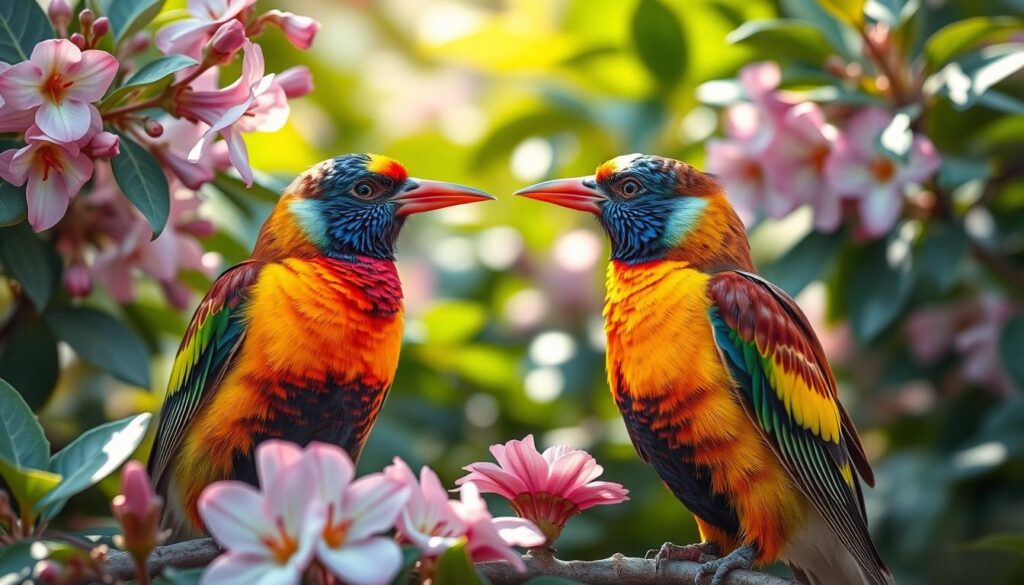Did you know that over 90% of birds are monogamous? Species like bald eagles, mute swans, and whooping cranes form lifelong bonds. Birds don’t kiss like humans do, but they have their own ways of showing affection.
They engage in behaviors like allopreening (mutual grooming) and courtship feeding. These actions are key for their social bonding, choosing a mate, and reproduction.
Key Takeaways
- Birds show love through behaviors like allopreening, courtship feeding, and beak-to-beak contact.
- These actions help strengthen bonds between mates and flock members, especially during breeding season.
- Parrots, cockatoos, pigeons, doves, and eagles are among the species known to engage in these behaviors.
- While birds don’t kiss their young, parents feed them in a way that might seem like kissing. This is crucial for the young birds’ survival.
- Concerns about human saliva being dangerous for birds are often overblown. Most avian experts say these worries are unfounded.
Understanding Bird Affection Displays
Birds show their love in many ways, from courtship rituals to grooming. These actions show how deep their social bonds are. Let’s look into how birds show affection.
Types of Physical Contact Between Birds
Allopreening is when birds groom each other’s feathers. It keeps their feathers in good shape and strengthens their bond. Beak touching is another way, where birds greet or show affection by touching beaks.
Social Bonding Behaviors
Birds have many social behaviors that show their love and bond. Courtship feeding is when one bird feeds the other. This shows the bird’s ability to care for its mate, important for breeding.
Species-Specific Interactions
Each bird species has its own way of showing love. For example, pigeons and doves show love by feeding each other. On the other hand, eagles do aerial displays to show their love.
“The depth of emotional connection between birds is truly astounding, and their affectionate behaviors never cease to amaze those who observe them.”
Exploring bird pair bonding and avian affection displays reveals a world of social interactions. It shows how birds express their love and devotion.
The Science Behind Avian Courtship Behavior
In the world of birds, courtship is key to breeding. It helps keep bird populations diverse. The Greater Sage-Grouse’s dances and the Mourning Dove’s “cloacal kiss” show the beauty of bird romance.
Most birds don’t have penises, but they still mate with care. Ducks and geese have special organs for mating. But most birds just have a quick “cloacal kiss” to exchange sperm, which can happen many times.
Courtship timing is linked to the environment. When days get longer and food is plentiful, birds start to mate. The Anna’s Hummingbird’s aerial stunts and the Barred Owl’s loud calls help attract mates and strengthen bonds.
Keeping the mating area private is vital for birds. Any disturbance can harm their young. The cloaca, used for mating and waste, grows during breeding, showing its importance.
Birds show their courtship in many ways, from dances to songs. Understanding these behaviors helps us appreciate their unique ways of finding love and ensuring their species’ survival.
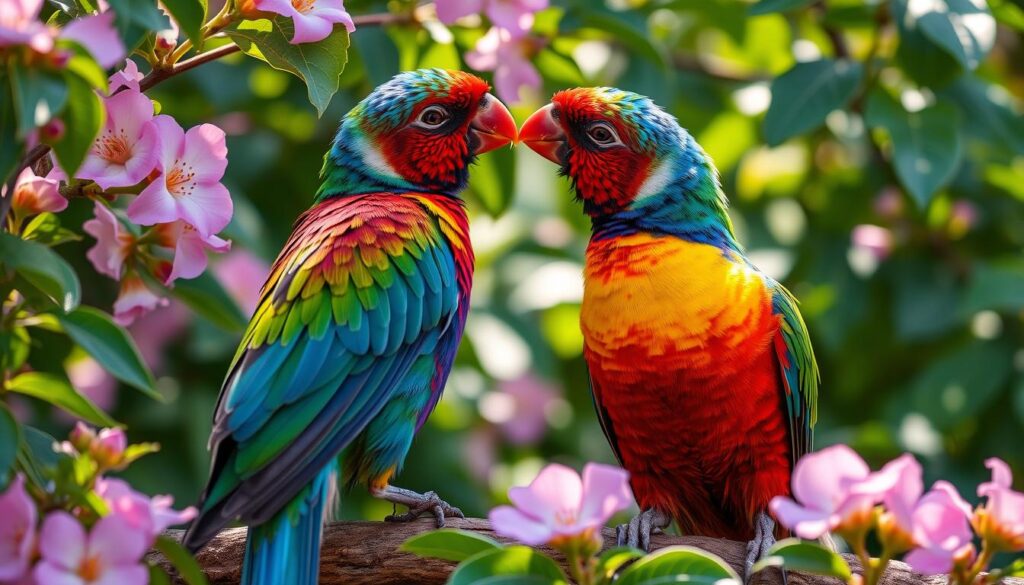
How Do Birds Kiss?
Birds don’t kiss like humans do, but they show love in their own special ways. One common way is through “allopreening.” This is when birds groom and preen each other. It helps them bond and clean parts they can’t reach by themselves.
Another form of “bird kissing” is when birds touch beaks during courtship feeding. In this act, one bird, often the male, feeds the other. It shows the bird’s ability to care for and feed potential offspring, which is key in choosing a mate.
Allopreening vs Human Kissing
Allopreening and human kissing may look similar, but they mean different things. Allopreening is about keeping feathers clean and strengthening bonds. Human kissing is about showing love and affection. Birds groom each other for practical reasons, not for romantic feelings.
Beak-to-Beak Contact Meaning
Beak-to-beak contact during courtship feeding is very important for birds. It shows the male bird’s ability to provide food, which is crucial for the female’s choice of mate. This act is a big part of the courtship rituals birds go through before mating.
So, birds may not kiss like humans, but they show love in their own ways. Allopreening and courtship feeding are key to their social and reproductive lives. Learning about these behaviors helps us appreciate the emotional lives of birds more.
Allopreening: The Bird Version of Kissing
In the bird world, “bird kissing” is called allopreening. It’s a way for birds to groom each other and build strong bonds. Birds like parrots, cockatoos, and some songbirds often do this. They touch their beaks together, showing trust, affection, and a desire to look their best.
Allopreening is key in birds’ social lives. It keeps their feathers clean and strengthens their relationships. For birds that mate for life, it helps keep their bond strong.
Allopreening also plays a part in courtship. Birds use it to attract mates and show they’re ready to pair up. Watching birds kiss is fascinating for bird lovers and scientists. It shows how birds communicate and live together.
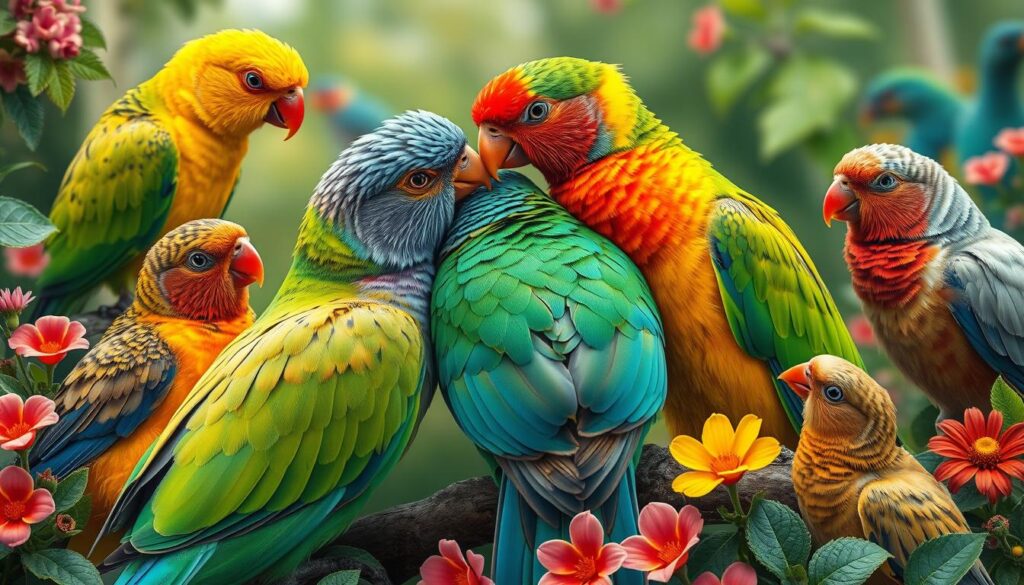
The way birds show love and friendship is amazing. From the Bird of Paradise’s dance to the gentle touch of beaks in allopreening, birds have many ways to express themselves. Learning about bird kissing techniques and other displays helps us appreciate their lives more.
Courtship Feeding and Its Significance
Bird courtship is a fascinating show of love. One key part is courtship feeding. This act, seen in birds like pigeons and eagles, shows the male’s ability to feed and care for his mate and future chicks.
Role in Mate Selection
Courtship feeding is key in bird mating. When a male feeds a female, he shows off his hunting skills and dedication. This act of care can influence the female’s choice of mate, showing he can be a good provider.
Seasonal Patterns
Courtship feeding happens more often during the breeding season. For example, in osprey pairs, it peaks before egg-laying. Older pairs do it more than younger ones.
This behavior is a key part of bird courtship behavior and avian mating rituals. It helps us understand the social and reproductive lives of birds.
Different Bird Species and Their Affection Styles
The world of birds is full of different ways to show love. About 90% of birds are monogamous. But, each bird species has its own way of showing affection.
Swans are famous for their lifelong love. They preen each other and make heart shapes with their necks. Pigeons and doves show love by feeding each other.
Big birds like geese and albatrosses stay with their mates for many seasons. They work hard to protect their territory and find a new mate each time.
| Bird Species | Affection Displays |
|---|---|
| Swans | Mutual preening, heart-shaped neck poses |
| Pigeons and Doves | Courtship feeding |
| Geese, Cranes, Albatrosses | Long-term pair bonds, defending territories |
| Atlantic Puffins | Sharing egg incubation and parenting duties |
| Laysan Albatross (Wisdom) | Lifelong bond with the same partner |
The world of birds is amazing. Bird pair bonding and bird romance are unique and interesting. From swans to big migratory birds, birds show us how diverse love can be.
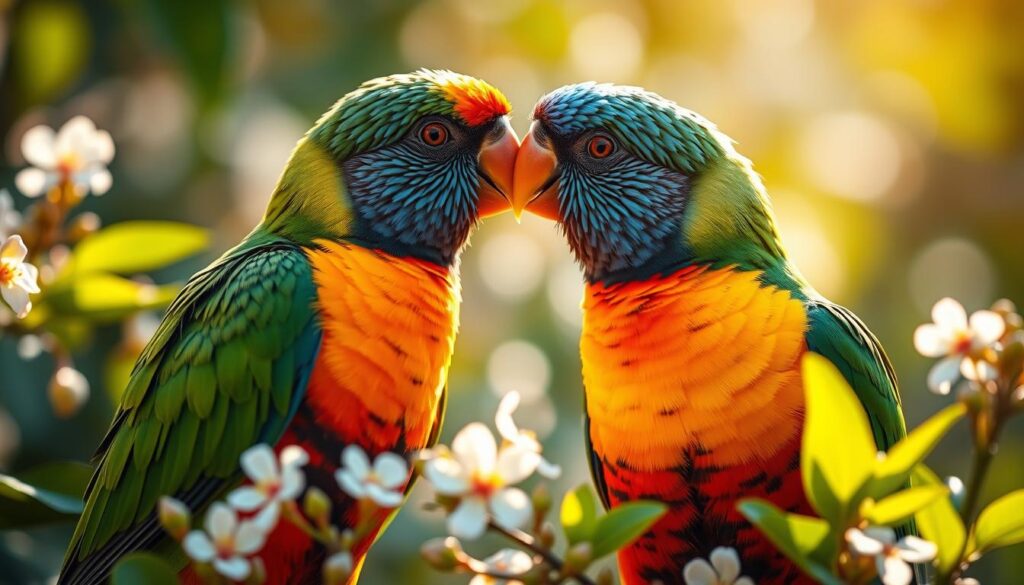
Parrot and Cockatoo Bonding Behaviors
Parrots and cockatoos are known for their strong social bonds and smartness. They show love and trust through allopreening, a special way of grooming each other. This behavior helps keep their flock together and strengthens their relationships.
These birds also talk to each other with beak touching. This can mean different things like affection, play, or even showing who’s boss. It’s a way for them to share feelings and set boundaries.
Social Grooming Patterns
Parrots and cockatoos have a detailed social grooming system. They take turns cleaning each other’s feathers. This keeps their feathers healthy and strengthens their bonds.
Allopreening happens during rest and when they want to show affection. It’s a key part of their social life.
Beak Touch Communications
The beak is very important for parrots and cockatoos. They use it to show love and communicate. A soft touch might mean they’re feeling affectionate, while a firmer hold could mean they’re showing dominance.
It’s important to understand how parrots and cockatoos bond. By knowing about their bird kissing techniques and social ways, we can connect better with them. This lets us see their emotional lives more clearly and build stronger bonds.
The Role of Physical Contact in Bird Relationships
Physical contact is key in bird relationships. Behaviors like allopreening, courtship feeding, and beak touching help with social bonding and choosing mates. These actions change based on the bird type and the season.
Allopreening is like kissing for birds. It makes their bond stronger as they clean each other’s feathers. Courtship feeding shows love and builds trust. Beak touching is a common way for birds to say hello and bond.
| Behavior | Purpose | Frequency |
|---|---|---|
| Allopreening | Strengthens pair bond | Highest during breeding season |
| Courtship Feeding | Builds trust and facilitates mate selection | Increases during courtship and breeding |
| Beak Touching | Greets and bonds birds | Occurs regularly in social interactions |
These physical acts are crucial for birds’ health and happiness. They help us understand the complex lives of our feathered friends better.
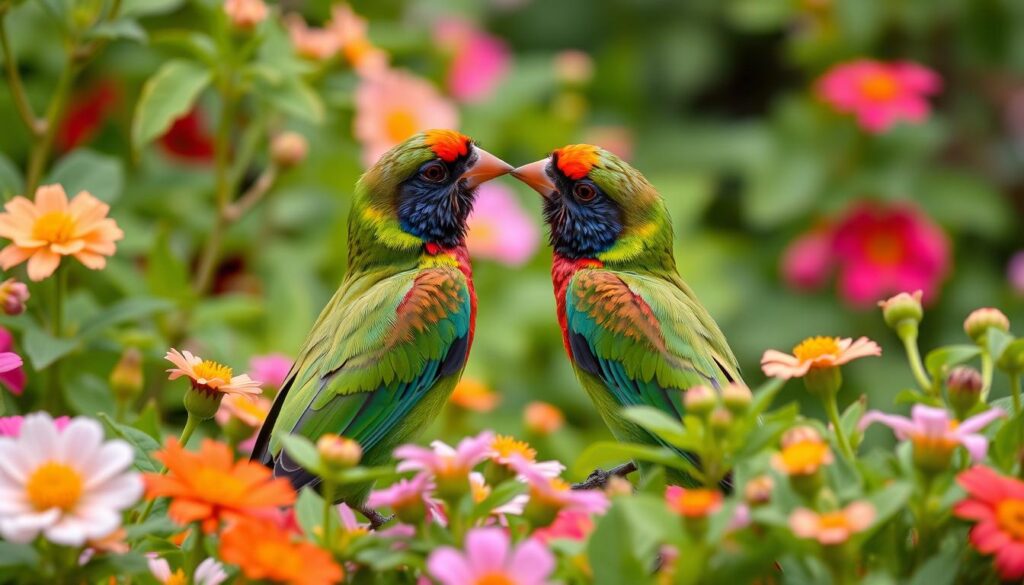
Parent-Chick Feeding Interactions
In the bird world, parent birds feeding their chicks looks like “bird kissing” to us. They use direct beak-to-beak feeding. This is key for the chick’s survival since they depend on their parents for food until they can eat on their own.
Feeding Techniques
Parent birds have different ways to feed their chicks, like regurgitating food or directly transferring it from their beaks. This close feeding not only gives the chicks food but also strengthens their bond with their parents. It’s important for the chick’s growth and social skills.
Bonding Through Nourishment
The feeding between parent and chick is more than just food. It’s the start of a strong emotional bond. As the chick depends on the parent for survival, feeding builds trust and love. This is good for the chick’s health and social behavior.
These feeding rituals are clear in birds like parrots and cockatoos. They hatch with no feathers and need their parents for everything. The reciprocal feeding during this time helps the chick feel secure and prepares it for growing up.
“The feeding process also strengthens the bond between parents and offspring, playing a vital role in chick development.”
Understanding parent-chick feeding is key to grasping bird kissing explained and avian mating rituals. These close behaviors are not just about love. They are essential to bird social and reproductive life.
Bird Body Language During Affectionate Moments
When birds show love and affection, their body language tells us a lot. From the head bobbing of parakeets to the wing flapping of cockatoos, these signs show us the beauty of bird romance and avian affection displays.
Parakeets, for example, show their love through head-bobbing. This is a key part of their courtship. Both males and females do this, showing their joy. Even baby parakeets use head-bobbing to ask for food, showing it’s a versatile sign.
Cockatoos, known for their love of touch, often flap their wings to get attention. They do this to bond with others, whether it’s their flock or humans. This need for touch is especially strong in captive-bred cockatoos, who miss out on wild experiences.
Knowing how to read bird body language helps us understand their feelings and social lives. By noticing these small signs, we can truly appreciate the depth of avian affection displays and how birds show their emotions.
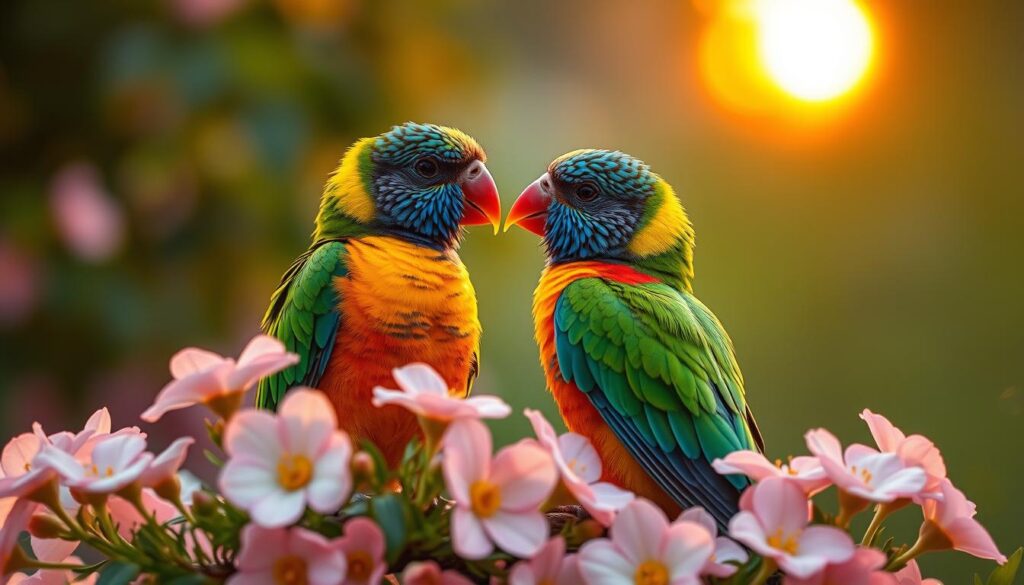
Safety Considerations for Bird-Human Interactions
The bond between birds and humans can be very special. But, it’s key to be careful about touching them. Many think kissing birds on the beak is okay. But, it can really harm both the bird and the person.
Bacterial Transfer Risks
Pet birds have different bacteria in their mouths. These can be harmful to humans. Also, human saliva has bacteria that birds don’t have. This can make birds sick if kissed on the mouth.
Lip products like lipstick or lip balm can also be dangerous. If a bird eats these, it could get very sick or even die.
Proper Handling Guidelines
To keep both birds and humans safe, follow certain rules. It’s okay to give birds a quick peck on the head or beak. But, kissing them on the mouth is not safe.
Psittacosis, a flu-like illness, can spread from birds to humans through close contact. Washing your hands often after touching birds or their things can help prevent sickness.
Instead of kissing, show love in other ways. Gentle petting and spending time together are great. This way, we can have safe and loving relationships with our bird friends.
“Kissing birds on or near the mouth can increase the risk of transmitting Psittacosis between humans and birds.”
| Health Risks | Recommended Practices |
|---|---|
|
|
Seasonal Changes in Bird Affection
Birds show different levels of affection with the seasons. During breeding time, they get more into courtship and bonding. Some birds stay affectionate all year, especially in long-term relationships or with their flock.
In spring, birds get very protective of their mates. They might act aggressively if someone tries to get close. This is their way of protecting their future babies and their genes.
But in the off-season, birds are more open to friends or humans. They do more allopreening and other bonding acts. This keeps their social bonds strong when it’s not mating time.
“Springtime, associated with increased hormone levels, can lead to behavioral changes in birds, including males becoming more aggressive and females displaying increased cuddliness and amorous behavior.”
Seasonal changes really affect how birds court and mate. Knowing this helps bird owners and fans understand their birds better. It lets them prepare for these changes in their feathered friends.
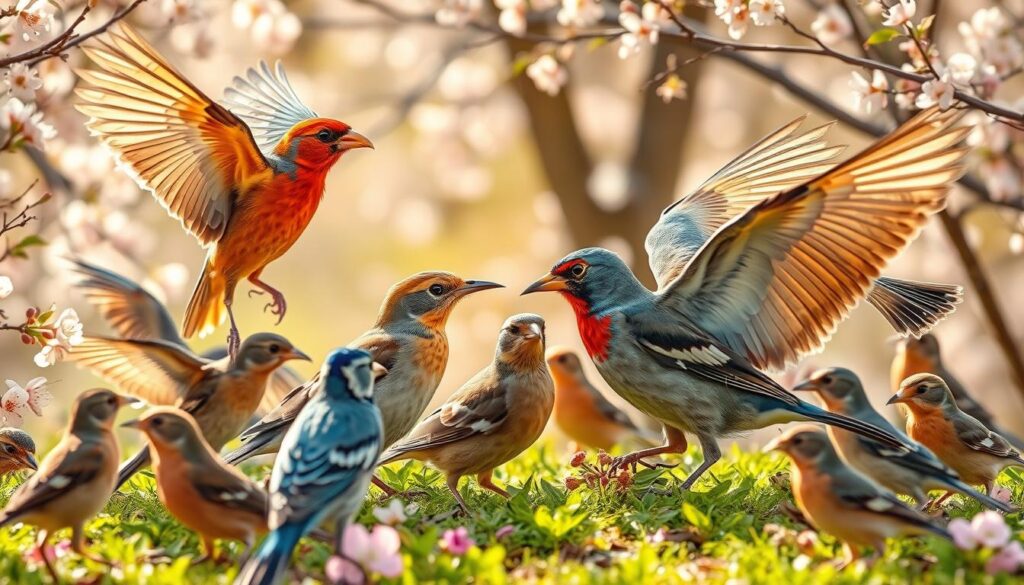
Building Trust with Pet Birds
Building a strong bond with your pet bird takes patience and understanding. It’s safe to gently kiss their head or beak, but respect their space. Avoid mouth-to-beak contact, as it might scare them. A nurturing environment makes your bird feel safe and valued.
Gentle handling helps build trust. Start by slowly moving your hand near your bird. Let them get used to you. Give them treats like fruits or veggies to make positive memories. Mimicking their natural behaviors, like grooming, also helps them feel closer to you.
The length of your bond matters too. Different birds live longer, like African Greys up to 50-60 years, and Cockatiels up to 15-20 years. Spend at least 1-2 hours a day with your bird to strengthen your bond.
Positive reinforcement, like treats, can speed up trust-building by 40%. Birds learn to associate their owners with rewards, leading to more social behavior. If your bird is aggressive or fearful, use slow trust-building and positive reinforcement to help.
Building trust with your bird is a journey. It needs patience, understanding, and a commitment to their happiness. Respect their boundaries, engage in positive interactions, and involve your family. This way, you’ll create a lasting and rewarding bond with your feathered friend.
| Bird Species | Average Lifespan |
|---|---|
| African Grey | 50-60 years |
| Cockatiel | 15-20 years |
Common Misconceptions About Bird Affection
Many people think all bird “kisses” or physical contact mean romantic love, like in humans. But, the truth is more complex. It’s about the needs and social lives of birds.
Myths vs Reality
One big myth is that all beak-to-beak contact is about love. But, it’s often about grooming, feeding, or building social bonds. Bird kissing explained is more about needs than emotions.
Another myth is that birds love like humans do. While birds do form strong bonds, their bird courtship curiosities are mainly for survival and social needs, not love as we know it.
Scientific Evidence
Science has really helped us understand bird affection. Studies show birds touch and show “affection” for many reasons, like:
- Strengthening social bonds within a flock or pair
- Maintaining healthy plumage through grooming behaviors
- Signaling readiness for mating and reproduction
- Communicating dominance, submission, or other social cues
These behaviors might look like human love, but they’re really about survival and social needs. Knowing this helps us see the real meaning behind bird kissing explained and bird courtship curiosities.
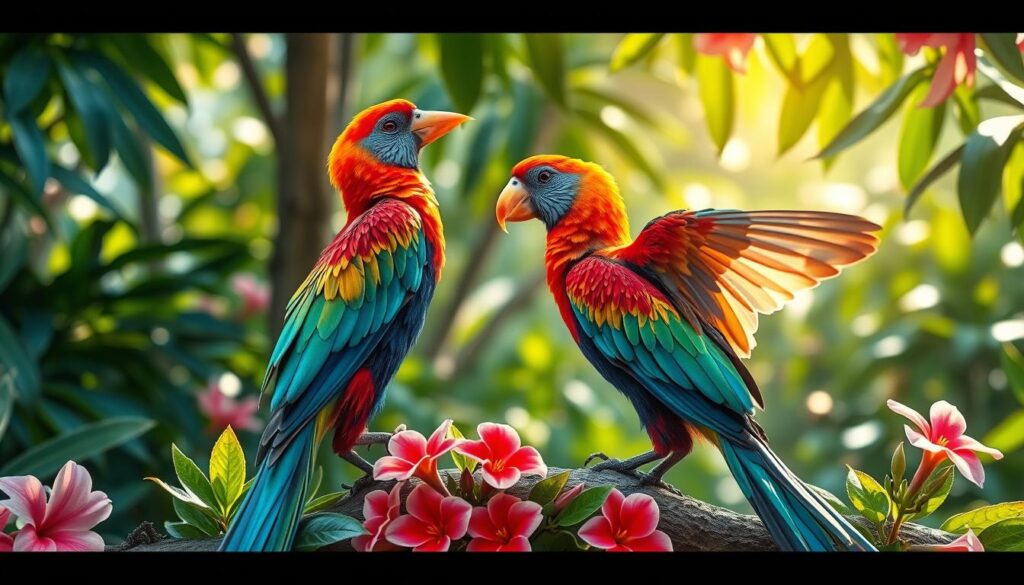
“Observing the diverse range of avian behaviors, from the intricate courtship rituals of pigeons to the shared parental responsibilities of certain species, provides a fascinating glimpse into the complex social dynamics of the bird world.”
Strengthening Bonds with Companion Birds
To build a strong bond with a bird, it’s important to understand their natural ways of showing love. By acting like them, offering the right touch, and doing fun activities together, you can create a deep connection. This connection is based on trust and care.
It’s key to know what each bird likes and needs. Some might love a soft head scratch or a gentle touch of beaks. Others might prefer to keep their distance. Paying attention to how they act and respecting their space helps build trust.
Adding bird romance and avian affection displays to your daily life can make your bond stronger. Sharing meals, working together, and playing can strengthen your bond. By doing things that come naturally to birds, you can make your relationship happy and rewarding for both of you.
FAQ
How do birds kiss?
Birds don’t kiss like humans do. But they do show affection in their own way. They might groom each other or share food. These actions help them bond and are important for their social lives.
What are the different types of physical contact between birds?
Birds show love in many ways. They might groom each other, touch beaks, or share food. Each of these actions has its own purpose and varies among different bird species.
How do different bird species show affection?
Birds show love in many different ways. Parrots and cockatoos groom each other a lot. Pigeons and doves share food, and eagles give food to their mates. Each species has its own special way of showing affection.
What is the role of courtship feeding in bird relationships?
Courtship feeding is key for many birds. It lets males show they can feed and care for their mates and young. This is common in pigeons, doves, and eagles.
How do parrots and cockatoos bond?
Parrots and cockatoos are very social and smart. They groom each other as a sign of love and trust. They also use beak touching to communicate, sending messages in different situations.
How do parent birds feed their chicks?
Parent birds feed their chicks in a way that looks like kissing. This direct feeding is vital for the chicks’ survival. It also strengthens the bond between parents and their young.
What are the safety considerations for bird-human interactions?
It’s okay to gently touch a bird’s head or beak. But kissing a bird on the mouth is risky. Human saliva can harm birds, and they might pass diseases to us. Always follow safe handling tips to protect both birds and humans.
How can owners build trust with their pet birds?
Building trust with pet birds takes time and patience. It’s safe to gently kiss them on the head or beak. But, it’s important to respect their personal space. Trust grows through gentle handling, treats, and mimicking their natural behaviors.
What are some common misconceptions about bird affection?
Many people think all bird “kisses” are about love. But, these behaviors are often about survival and social needs. Birds do form strong bonds, but their displays of affection are not the same as human emotions.
